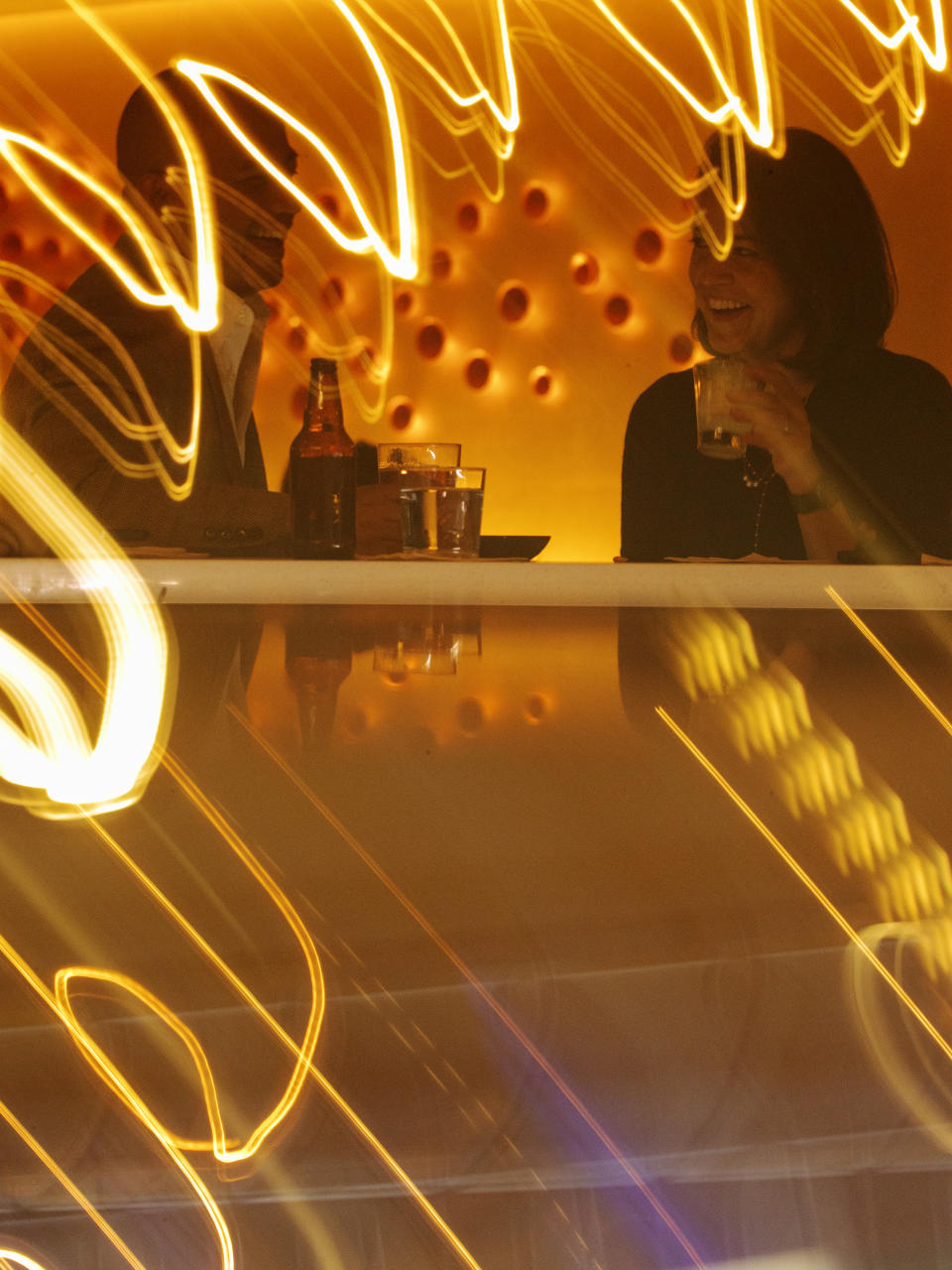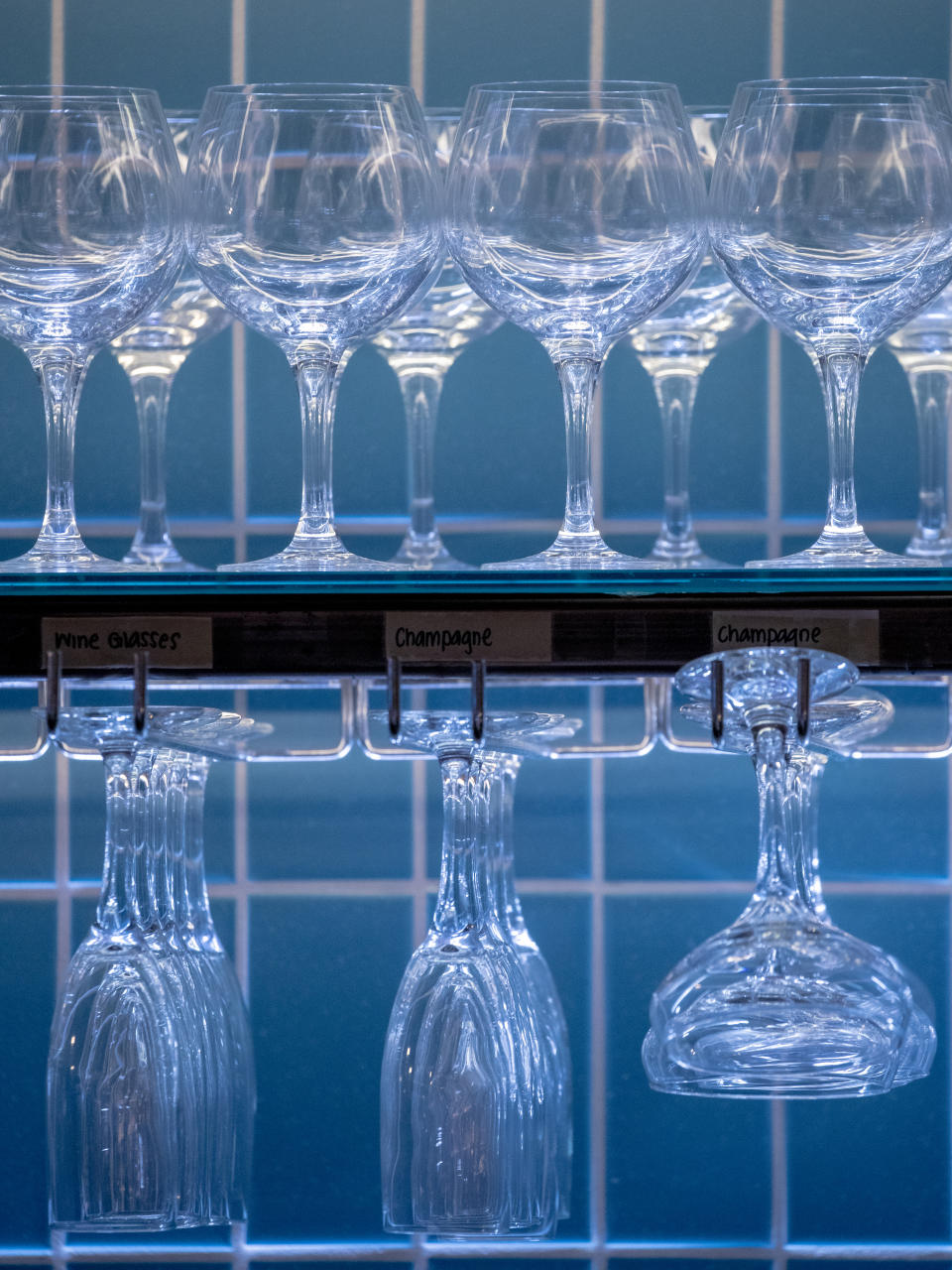Why restaurants are so loud, and what science says we can do about it
An acoustics professor, a food critic and an audio producer are staring at their devices in a Peruvian restaurant in downtown Washington.
“What are you getting?”
“Let’s see … it’s fluctuating.”
“I just got 80.”
“Whoa, it just spiked to 87!”
These are sound-level readings taken from our table - a corner booth overlooking the dining area of Pisco y Nazca. I’m Bishop Sand, an audio producer at The Washington Post, and I’m here with Lily Wang, who runs the acoustics program at the University of Nebraska at Lincoln’s Durham School of Architectural Engineering and Construction, and my colleague Tom Sietsema, The Post’s food critic for the past 24 years.
Sietsema eats out about 10 times a week for work, and for each review, he notes the sound level readings in decibels. In his 2019 review of this restaurant, Sietsema began: “If you’ve ever wondered how loud a jet engine sounds at takeoff, I can give you an approximation.”
He was not exaggerating. The sound levels blow away a normal, 60-decibel conversation.
“This is the loudest restaurant I’ve ever reviewed in D.C.,” he tells us as we look over the menu. “Here, it was 100 decibels at the bar during happy hour, and not much better in the center of the dining room.”
I start to ask how many of his reviews warn diners that they’ll need a raised voice for conversation at the restaurant. He cuts me off before I can finish my question.
“Seventy percent,” he says. “I’ve run out of adjectives to describe a noisy restaurant.”
Sietsema began recording and publishing decibel levels in his reviews in 2008 in response to reader feedback. More than a decade later, the problem persists. Noise was the most cited complaint in Zagat’s last Dining Trends Survey in 2018, and it continues to dominate the conversation in online restaurant reviews. Sietsema says behind tipping, a quiet restaurant is the most requested piece of advice in his weekly live chat sessions.
To be fair, the average noise level in restaurants may not be shooting up. Standardized methods to measure restaurant noise are in development, but the latest data from a popular sound-reading app suggest noise is plateauing at lower than pre-pandemic levels. Some acousticians believe we simply became used to quieter surroundings during the pandemic, which could make us more aware of loud environments.
It’s still noisy out there, and Wang and other experts point to mounting evidence that excessive noise is more than a minor inconvenience. Our brains have a tough time sorting through the cacophony in crowded dining rooms, which can influence our behavior. Multiple studies show that prolonged exposure to noise has physical effects such as increased anxiety and fatigue. Taken together, these effects can make the restaurant experience more taxing than relaxing for patrons, and they can leave staff drained from a long day straining to offer service while risking permanent hearing damage.
Experts are advocating for standards that would not only alleviate customer complaints, but also protect the health of patrons and staff members. And with the number of people dining out slightly declining after a pandemic rebound, restaurateurs should have more motivation to try new technologies and materials to suppress noise and lure more diners to their tables.
- - -
The science of how sound moves
As we wait for our server to come take our drink orders, I lean back against the firm gray padding in our booth and try to pick out the sounds swirling around me. There are other diners talking, of course. There are waitstaff and bartenders calling out. The open kitchen sends out the clatter of plates, utensils, pots and pans along with the whoosh of ventilation. And then there is the thumping music from the ceiling speakers.
I spot a rectangular object hanging on the wall behind Sietsema. It’s a blank beige canvas designed to absorb sound. I have hope! Maybe Sietsema’s review made an impact and the restaurant owner has implemented sound dampening measures? But then I remember it’s only 6 p.m. It could easily get louder.
Wang is here to help us understand the science of this soundscape. She’s the former president of the Acoustical Society of America, and she holds the most prestigious awards in the field. She puts me at ease with a big laugh and apologizes for slipping into “academic speak.”
She introduces herself to Sietsema as an acoustician - “Most people think I play the acoustic guitar when I tell them that!” It actually means she studies sound: how it’s created, how it moves and how it’s received.
Wang says that each clinking of cutlery and every vowel uttered by a diner makes sound by vibrating molecules in the air. This vibration moves away from the source not in a straight line, like a laser beam, but outward in a growing sphere of sound waves.
The scene gets more complicated when these waves interact with all the objects in a room. In this dining space, we have bottom-lit walls with a large art piece made of orange ceramic cups, wood floors and ceilings, a few plants in white ceramic pots, sleek wooden furniture and lots of people.
When a sound wave hits anything in here, three things can happen, depending on the materials involved. “Some gets reflected,” Wang says. “Then there is some of it that will … continue propagating … and then there is some that is absorbed.”
A solid, smooth, stiff barrier - such as painted concrete, metal or glass - will reflect most of the sound back into the room. The nearby bar is tiled in a stunning shade of blue that looks incredible, but it must be reflecting our noise back to us, just like the smooth ceilings, walls and floors.
Pisco y Nazca is nestled just below street level. The ceilings are low. In this confined space, our voices have the chance to reflect several times off the nearby polished surfaces, staying active and hitting many more people’s ears.
- - -
Noise levels can change quickly with different treatments.
Professional acousticians use these simulations to model sound behavior. In the first scenario, the room has no sound treatment. In the other, the room has wall panels and separators.
In a fraction of a second, much of the sound in the room with mitigation measures becomes trapped within the separators, while sound that escapes is partially absorbed by wall panels.
The overall noise level in the room with mitigation measures is reduced quickly.
After a quarter of a second, the room with sound-dampening measures contains only very soft and dispersed reverberations.
“I do think that’s an issue with why restaurants have gotten louder, because I think there’s been an aesthetic change,” Wang says. “You know, we want to design a vibe that’s either kind of industrial or cool.”
Three tables get seated around us. Women arrive in bright, flowing dresses. The men take off their sunglasses and assess the dining room. I ask how our fellow diners affect the noise level, and Wang explains that while people are sources of noise, their bodies also act as sound absorbers and reflectors.
“You know, concert halls design chairs to absorb the same amount of sound as a normal human body,” she adds. “That way, it sounds the same whether or not it’s a packed house.”
- - -
What noise does to your health
The waiter arrives. Sietsema exudes expertise - right down to his posture in a booth - so Wang and I readily agree when he offers to guide us through the experience. He orders for the table, rattling off decisions for appetizers and entrees. We place our drink orders.
“I’ll have a pisco sour!” I say. It’s a Peruvian drink made from a brandy-like alcohol, egg whites and lemon.
Alcohol and noise work together in interesting ways. Alcohol blunts our hearing - especially at lower frequencies. This means when I reach the legal limit to drive, my brain will turn down the volume of most sounds I’m hearing in a restaurant. This effect may give me some relief from the music, but it will also drown out voices. It explains why intoxicated individuals talk louder: They don’t hear themselves as well as they normally do and speak up to compensate.
Strangely, noise also seems to drive more alcohol consumption. French researchers discovered this effect by raising music levels in bars by about 15 decibels and recording the number of drinks served. Researchers aren’t sure why this happens, but they hypothesize that people drink more because they can’t easily talk when the noise increases.
During a break in our conversation, I open up a sound-level app called SoundPrint. It measures the room for 15 seconds and displays a reading of 83 decibels. “Very loud,” is the assessment. The app then offers to register a complaint to the restaurant.
The app’s developer, Greg Scott, has been looking at data collected from about 14,000 active monthly users from more than 6,000 restaurants during the past four years, and he’s optimistic venues are not getting louder. According to Scott’s data, the average decibel readings in restaurants have been below 77 - what Sietsema would rate as “requires a raised voice” - for the past two years. Scott says the number of restaurants rated in the app as “conducive to conversation” has increased to roughly 40 percent, while the number of “excessively loud” restaurants has dropped to 30 percent.
Appetizers arrive. Ceviche, empanadas and tuna on potato cakes.
The music dies down, and we talk at length about Wang’s early aspirations of becoming a concert hall designer. Sietsema makes notes about the food. We realize that our conversation is flowing in this sonic environment. The noise right now is not a problem. Sietsema is giddy and points out that all restaurants should be this way.
“You know the word ‘restaurant’ comes from the French word ‘restaurer,’ which means ‘to restore.’ It shouldn’t be a place that’s wild and crazy,” Sietsema says.
Our entrees arrive, and I’m intrigued by lomo saltado, a Peruvian classic that involves steak, fries and rice in a soy sauce and au jus mixture. The meaty smell hits us, and we quietly dig in.
“The meat is cooked a little tough, and the onion kind of perks it up,” Sietsema offers. “But the best thing about this dish is the french fries, right? They’re really great when they soak up that soy sauce underneath.”
Wang leans in to say she loves our other entree, the chicken stew with rice. She is very conscious about raising her voice in a place like this, because she knows most people subconsciously react to a loud environment by raising their voices. That would add more sound to the room and cause nearby people to talk over the raised volume - a feedback loop that is so predictable it has a name: the Lombard effect.
Any gathering of people will produce the Lombard effect, but restaurants seem particularly susceptible because of the confined spaces filled with talkers.
Sorting through noise in restaurant dining rooms is particularly taxing to our brains, studies have shown. Working memory is under high demand when we need to switch our attention from one voice to another in a sea of voices.
All hearing people exert effort to listen in a noisy environment, and unsurprisingly, people who have hearing loss need to exert themselves more. People with autism spectrum disorder have both a higher sensitivity to noise and difficulty in filtering background noise from speech, research has found.
Age also plays a role in cognitive processing, with older people finding it more difficult to switch attention from one speaker to another. Filtering out the noise is such a cognitively demanding task that a study in Amsterdam was able to track cognitive decline by looking at people’s filtering ability.
In addition, our brains tune our hearing to match our environments, so our perception of loudness shifts while in a loud environment - sometimes permanently. And the higher the volume we’re exposed to, the more likely we are to lose our hearing.
We flag down our waiter and ask him about how he feels after working in the noise. He says he’s tired at the end of the shift because of the sound. Studies of naval crews and oil industry workers find prolonged noise increases fatigue.
I feel for the wait staff who must patiently record food orders, often bending down and leaning in to get information. Roger Schwenke of Meyer Sound Laboratories told me that when his company installed acoustic treatments for a restaurant, the first thing servers said they noticed was that their back pain immediately vanished.
Noise also triggers stress hormones to flood our bodies. Over time, blood vessels stiffen and blood pressure soars. Inflammatory responses course through our organ systems, studies showed, eventually leading to cardiovascular disease, heightened anxiety and increased feeding behavior.
At 95 decibels, scientists observe people and rodents eat less and consume food faster. Wang suggests that this fact may be understood by restaurant managers trying to turn their tables. I’m not as cynical.
- - -
So what can restaurants and diners do?
Dessert time. Caramel cookies, flan and the tres leches cake are all fantastic. Wang boxes up the leftovers for her kids.
Before we go, I notice another beige sound panel on the ceiling near the bar. I look closely and notice two more panels on the wall. Back by the kitchen, there are sound absorption panels on nearly every surface.
Materials that absorb sound have been decidedly uncool to install in restaurants. Sound absorbers are thick, porous and fluffy materials such as foam or fiberglass placed in ceiling tiles and wall panels. They work by channeling sound into “tortuous paths” (yes, that’s the technical term) that increase friction and make sound waves bend the fibers. The result is less reflected sound, especially at higher frequencies - but it leaves a room with an office vibe.
Such treatments can also be expensive. Acoustic consultants, who work with restaurateurs and architects to optimize sound for venues, estimate sound treatment is about 2 to 3 percent of a new venue’s total building costs. When asked what a few thousand dollars will get, some consultants said they would offer pointers, like spacing out the tables from each other and moving diners away from necessary sound sources such as a ventilation system or the kitchen. Others chuckled, saying that kind of money wouldn’t get you lunch with an acoustic consultant.
But each consultant said this upfront cost often saves money; otherwise, complaints roll in and business must be halted to tear apart and rebuild structures to install better acoustic materials.
These days, some companies offer newer materials that will dampen sound while being aesthetically pleasing.
Hollow metal panels hung from ceilings can be tuned to absorb specific sound frequencies. And nearly any kind of wood, plaster or even glass can be changed to absorb sound. Microperforations and slats allow sound to penetrate the surfaces, channeling sound internally and deadening the acoustic energy.
Another way to treat a surface is to pack it with fiberglass material and cover it with a thin plaster or fabric to let the sound energy penetrate. Even ceiling tiles, the most standard acoustic treatment in any space, have been made more aesthetically pleasing by patching their seams, making a smooth appearance.
“We’re making hard-looking things acoustically soft,” says Bennett Brooks, who runs an acoustic consulting firm based in Florida and Connecticut.
Beyond this, acousticians describe “microclimates” in restaurants, where tables have physical barriers floating above them in the form of absorbent clouds that double as light sources. The clouds prevent your voice from scattering to another table while reflecting your sound back to you and amplifying it for your companions.
Sietsema advises people to avoid noise by eating early when the dining room is less full, or by asking to sit in booths or away from others. He has advocated for quiet hours, where restaurants take on the feel of a quiet car on a train.
Wang is pushing for the Acoustical Society of America to create a standard system for restaurant noise - think double-black diamonds on ski slopes to warn you of extreme danger. Brooks laughs at the idea of developing any kind of regulation.
“Restaurants are like the most pure expression of the free market,” he says. “Sound regulations really start at the boundary of the building. To go inside and regulate that, well, that would take some real political muscle.”
Brooks believes change would more likely come from crowdsourcing apps and spreading restaurant noise information to the masses, like Sietsema has been doing for the past 15 years.
Rosa Reyes, regional manager of Pisco y Nazca, said in an email that managers installed the panels I noticed because of Sietsema’s 2019 review and their internal research into the noise problem. Reyes notes that after installing many two-by-three foot panels, the restaurant recorded a huge decrease in sound complaints from guests.
I say goodbye to Wang and Sietsema and step onto the street. The city softly hums, and I feel a physical relief after having to parse words within a barrage of voices. I remind myself this experience was nothing like the jet engine-level sound the restaurant produced in the past - and I vow to consider my health when choosing my next dinner out.
- - -
About this story
Odeon Room Acoustics Software simulated a single dimension of a sound impulse moving through a hypothetical restaurant. Simulated separators between tables and sound absorbing panels on the ceiling and one wall affected the sound’s movement and intensity.
Photographer Béatrice de Géa spent one chilly evening in December at Pisco y Nazca in downtown Washington exploring how to capture the sounds in a restaurant through images.
Related Content
One graduate’s quiet protest: Bringing a banned book to commencement
The real dolphin tale: They’re smart, sometimes vicious and highly sexed
Trump makes sweeping promises to donors on audacious fundraising tour









